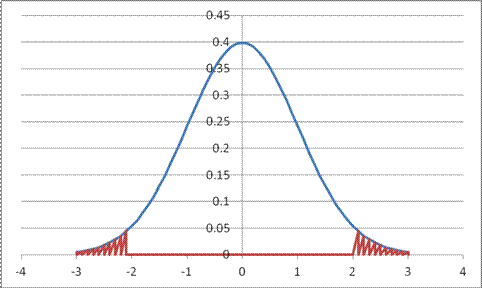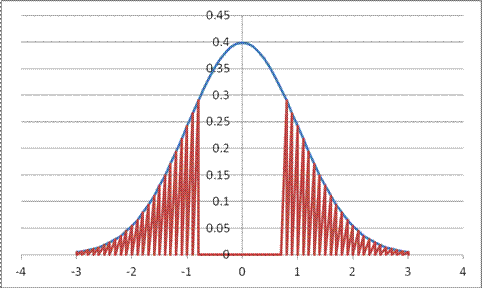|
Homework
#2 Possible Solutions Econ B2000, MA Econometrics Kevin R
Foster, CCNY |
|
|
- Experiment with the file, samples_for_polls.xls, to create at
least 100 polls, each with 30 people in it. Show a histogram of the percent, in each
poll, who support the candidate.
What is the mean of all of the poll averages? What is the standard deviation of the
averages? Does this seem
reasonable? What if support for the
candidate were just 10% -- what is now the histogram of 100 polls? What is its mean and standard deviation?
[You can use a nicer program than Excel if you want. Just please make sure to include your
work in the homework submission.]
Answers will vary.
- Experiment with the file, example_of_normal_distn_of_means.xls,
to create a variable with a new distribution (as explained in the Excel
sheet). Does its
mean seem to have a normal distribution?
Can you find a any that don't have a normal distribution?
Answers will vary.
- Please complete Exercise 2.6 in the textbook.
|
|
Y=0 |
Y=1 |
marginal |
|
X=0 |
0.037 |
0.622 |
0.659 |
|
X=1 |
0.009 |
0.332 |
0.341 |
|
marginal |
0.046 |
0.954 |
|
E(Y)
= 0*.046 + 1*.954 = .954. The
unemployment rate is the fraction who are unemployed (with Z = 1, where Z = 1
Y) , so .046. The unemployment rate for
the first row is the conditional mean, so .037/.659 = 5.61%; for the second row
is .009/.341 = 2.64%. Then conditional
on being unemployed (in column 1) what is the likelihood of being in the first
row? This is .037/.046 so 80.4% of the unemployed are not college grads and
.009/.046 = 19.6% are college grads. The
rates are not independent college grads make 34.1% of the labor force but
19.6% of the unemployed; these rates are not equal.
- Please complete Exercise 2.22 in the textbook.
With R = wRS + (1 w)RB, we know that the
mean of R is a weighted average of the means of the stock and bond funds so R =
.08w + .05(1 w); if w=.5 then R=.065.
Its standard deviation is ![]() so, noting that
we're given the correlation not the covariance so we must multiply the
correlation times the two standard deviations, the portfolio stdev is
so, noting that
we're given the correlation not the covariance so we must multiply the
correlation times the two standard deviations, the portfolio stdev is ![]() . With w=.5 this
is .044. With w-.75 the mean is 7% with stdev of 5.58% -- higher return but riskier. If we wanted just to maximize the expected
return then we would want as big a stock position as possible; either w=1 or
even higher. Higher w means a negative
weighting in bonds this means taking a loan i.e. going short in bonds. Typically there is some limit to the amount
of the available loan; if, say, (1 w) ≥ -1 then w=2 and the expected
return is 16%. But this is very risky
(13.6% stdev); the minimal risk, where the stdev is lowest, is not to short the stock and buy all
bonds but (because of the covariance), which is about .18 (find by
experimentation or differentiating).
. With w=.5 this
is .044. With w-.75 the mean is 7% with stdev of 5.58% -- higher return but riskier. If we wanted just to maximize the expected
return then we would want as big a stock position as possible; either w=1 or
even higher. Higher w means a negative
weighting in bonds this means taking a loan i.e. going short in bonds. Typically there is some limit to the amount
of the available loan; if, say, (1 w) ≥ -1 then w=2 and the expected
return is 16%. But this is very risky
(13.6% stdev); the minimal risk, where the stdev is lowest, is not to short the stock and buy all
bonds but (because of the covariance), which is about .18 (find by
experimentation or differentiating).
- Calculate the probability in the following areas under the
Standard Normal pdf with mean of zero and
standard deviation of one. You
might usefully draw pictures as well as making the calculations. For the calculations you can use either
a computer or a table.
a.
For a Standard Normal
Distribution, what is area to the right of 1.6?
Can sketch this as

The area is calculated from NORMSDIST(1.6), which is .945 so the
remaining area is .055 or 5.5%.
b.
For a Standard Normal
Distribution, what is area to the right of 2.3?
Sketch as

Calculate as NORMSDIST(2.3), the area to the left, which is
0.989, so the remaining area to the right is 0.011 or 1.1%.
c. For a Standard Normal Distribution,
what is area to the left of 0.9?
Sketch as

Calculate as simply NORMSDIST(0.9)= .816.
d. For a Standard Normal Distribution,
what is area to the left of -1.1?
Sketch,

Calculate simply NORMSDIST(-1.1) = .136.
e. For a Standard Normal Distribution,
what is area in both tails farther from the mean than -1.9?
Sketch,

Now to calculate, NORMSDIST(-1.9) gives 0.029 but this is just
the left tail; both tails have twice the area so 0.057.
f.
For
a Standard Normal Distribution, what is area in both tails farther from the
mean than 2.1?
Sketch as

Then again calc NORMSDIST(2.1) = .982, then (1 - .982) = .018,
which is the area of the right tail.
Multiply by two to find area of both tails, 0.036.
g. For a Standard Normal Distribution,
what values leave probability 0.041 in both tails?
We know that the answer will be something of the form, ąZ, for
some number Z. In the previous
questions, we found that when Z is 1.9 the area is 5.7%; when Z is 2.1 the area
is 3.6%. So we know that to get 4.1% we
will want some number between 1.9 and 2.1.
To figure it out we run our previous calculations backwards first divide
the probability by 2, so getting 2.05%.
Then use NORMSINV(.0205), which gives -2.044; the area to the left of
-2.044 is 2.05%. So the area in both tails
beyond ą2.044 is 0.041.
Sketch,
 .
.
h. For a Standard Normal Distribution,
what values leave probability 0.223 in both tails?
Again, divide the probability by 2 so
0.1115. Then NORMSINV(.1115) = -1.219.
Sketch,
 .
.
i.
For
a Standard Normal Distribution, what values leave probability 0.469 in both
tails?
Divide the probability by 2 to find 0.2345, so NORMSINV(.2345) =
-.724. Sketch,
 .
.